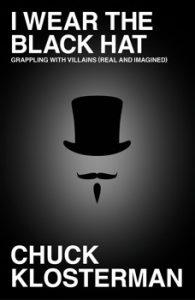In his latest excellent nonfiction book, “I Wear the Black Hat” (July 2013, hardcover), Chuck Klosterman intriguingly analyzes several fictional and historical villains and closes with a chapter on Adolf Hitler, noting how delicate he has to be when writing about this man we all accept as the embodiment of evil. While Hitler undeniably was evil, the author posits that society needs Hitler to remain the embodiment of pure evil – far off the grid from the theoretical second-most evil person — for the basis of moral comparison.
Klosterman best demonstrates this phenomenon when he asks a reader to picture Hitler, then to picture Stalin or Mao Tse-tung. While all are murderers millions of times over (and Tse-tung is far and away the record-holder for mass killings), most of us wouldn’t recognize a picture of the latter two, whereas Hitler can be easily doodled. Klosterman writes:
The vision of Hitler is so engrained in people’s minds that NBA legend Michael Jordan was roundly ridiculed for appearing in an underwear commercial with a mustache that vaguely resembled the one worn by Hitler.
When I’m in a particularly obsessive “Star Wars” phase, I get worked up about essays on Darth Vader’s villainy in the way that Klosterman is concerned a theoretical reader will get worked up about a Hitler essay:
What was the upside? I certainly did not want to write anything that could be misinterpreted as an apology for Hitler, which seemed [almost inescapably] likely, unless I just typed the sentence ‘Hitler was evil’ over and over and over …
Star Wars Insider titled an article “Darth Vader: Victim or Villain?” a few issues ago, and the title alone kinda made me mad. Luckily, all the “Star Wars” authors interviewed decided that he’s a villain (although some said he’s “both”). While I understand the intellectual value of trying to understand the motivations of a bad guy – and being able to see the tragedy of his story – it still makes me queasy to tiptoe into Vader’s mind. The fear, of course, is that I might find him the teensiest bit relatable. Replace the safely fictional Vader with the real Hitler, and such a concept is downright nauseous. Thus, Hitler is really hard to write about in a book that aims to understand villains – even though he’s the obvious subject choice.
Klosterman’s central premise is that a villain is “the person who knows the most and cares the least.” While it doesn’t always fit – after all, Hitler and Darth Vader were passionate, and that’s a form of “caring” – it’s a good starting point for exploring evil. I take “caring” to mean “wanting people to view you as a good person.” Although some religions and philosophies disagree, I think one’s intentional actions (with no “ends justify the means” excuses allowed) are what really matter. Even if you do good only in order be seen as good by others and therefore to feel good about yourself, I think you are a good person. Conversely, bad people are those who don’t even care what other people might think of them.

I take “knows the most” to refer to the idea that a smart person will get away with villainy whereas an unintelligent person will be stopped. By knowing the big picture of how human beings think and absorb the world around them, a savvy, uncaring person can do evil and trick casual observers into seeing those actions as neutral, or at least explainable, or maybe even good. Numerous politicians, modern and historical, could serve as examples here.
In a 2001 episode of “Angel,” the title character “knew the most” when a supernatural being showed him that the elevator to Hell opens at the same place it starts: on Earth. But it is not depressing knowledge to a caring person such as Angel; it is kind of wonderful. Angel tells the equally spiritually adrift Kate: “If nothing we do matters, then the only thing that matters is what we do.” This quote so crystalized my stance of disliking religion yet loving the beautiful things about life that I still use it as a one-sentence summation of my worldview.
To put it another way: I believe the quickest way for the world to become a better place would be if suddenly, overnight, everyone started judging people on their actions rather than their words. In my opinion, defenses of even short-of-Hitler-level-evil warmongers such as the troubled Darth Vader or the often-revered Abraham Lincoln are almost impossible when one looks at their actions, which caused the deaths of hundreds of thousands. Killing, through intent or ill-advised exercise of authoritarian power, is the ultimate evil, in my opinion. And the more people you kill, the greater the magnitude of your evil. While this is my thought, not the author’s, Klosterman touches on the idea of the overrated power of words in his chapter on how President Clinton came out of the Monica Lewinski scandal largely unscathed. Clinton, though obviously the villain of the scandal (based on his actions), doesn’t ever talk about it. What a person says — and doesn’t say — is a much stronger factor than their actions when it comes to how they are perceived by the masses.
Likewise, Klosterman demonstrates how O.J. Simpson enhanced his villainy by asserting his innocence and seeking the spotlight, to the point of writing the part-biographical, part-“fictional” “If I Did It.” While Simpson never would’ve been liked – obviously, murder is far less forgivable than adultery – he could’ve at least been somewhat forgotten by the public if he had chosen self-imposed exile.
Here are a few more of the off-beat (yet totally on-point and accurate) notions from Klosterman that make “Black Hat” so entertaining and provocative. As you can tell, the author explores a wide range of “villains,” with many of them not being nearly as serious as what I was talking about above:
- As we get older, our capacity to hate something decreases. Klosterman used to hate the Eagles. I remember one of his old Fargo Forum articles where he wished an anvil would land on Don Henley’s head. But in this book he writes: “Once you realize you can’t control how you feel, it’s impossible to believe any of your own opinions. As a result, I can’t hate the Eagles. It feels impossible. It feels stupid. The Eagles are real, but they don’t exist; they only exist as a way to think about ‘the Eagles.’ “
- He believes that a person’s charisma plays a big part in whether we perceive them as evil, noting that D.B. Cooper did the same thing – hijacking a plane – as the 9/11 terrorists. Yet he was charismatic and is now seen as an intriguing mystery. I think it’s crucial that – unlike the 9/11 terrorists — Cooper didn’t actually kill anyone (except, probably, himself), so Klosterman’s analogy doesn’t totally work (which he admits). But I see what he’s getting at.
- Klosterman’s chapter comparing Batman to Bernhard Goetz – who killed muggers in a New York City subway in the 1980s — is my favorite of the book, because he shows how fictional vigilantism is seen as heroic whereas real-life vigilantes are ultimately seen as dangerous people who should be stamped down just as surely as the criminals they are fighting. Klosterman argues that this is appropriate – “In a book or movie, the vigilante cares about us. In life, he cares more about the squirrels. It’s the only way.” But he didn’t convince me. I think a theoretical world where everyone is a vigilante, and everyone acts for good, would be a wonderful, just place. I’ll keep Klosterman’s writings on fictional and real-world vigilantism in mind as it pertains to Casey Jones as I continue my “Teenage Mutant Ninja Turtles” readings this year. Casey might’ve become my favorite TMNT character after reading this chapter.
- The chapter on comedian/provocateur Andrew Dice Clay is my second favorite. Klosterman argues that, judging by how these things usually go, Clay’s edgy material – while widely loathed in his heyday of the late 1980s – should now be enjoying a resurgence of respect. But society needed someone to be the symbol of 1980s vulgarity that was defeated by 1990s political correctness, and Clay fit the bill so perfectly (his material was atrocious, and not enough people believed that his stage persona was a “character”) that he’s not allowed to have a second wind to his career.
- Another great Klosterman observation in “Black Hat” is that “The future makes the rules.” Progressive ideas – such as equal rights – always win in the end. (“Progressive” is a touchy word here, because while I favor progressive ideas in a societal sense, I think a government enforcing progressive ideas is one of the most destructive things on the planet due to – unintended or purposeful — costs in treasure, liberties and lives.) For example, 100 years from now, people won’t be looking at that odd time in the early 21st century when people briefly thought gays should have equal marriage rights before society settled back into the comfortable notion that some people don’t deserve certain rights. Klosterman also notes that some progressions are neutral or even bad (machines gaining awareness in the “Terminator” movies is the most visceral sci-fi example), but that progression – the future — is inevitable. He writes respectably even-handed essays on Julian Assange and Kim Dotcom. Although I could criticize Klosterman for avoiding strong stances (I think Assange is a hero of liberty, but Klosterman sees him as somewhere in a middle ground), ultimately it’s a good thing that he sees things from all sides of an issue. And besides, we have plenty of political writers; Klosterman might be the elite apolitical essayist of our time.
For another take on “I Wear the Black Hat” and Klosterman’s writing style, check out Mitchell Brown’s review at his blog.

